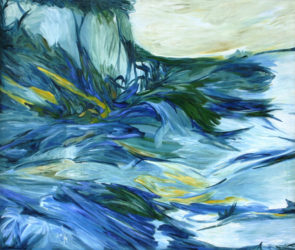Artists Stanley Greaves AA and Akima McPherson discuss Cletus Henriques’s oil painting River’s Edge, which was completed in 1968. This is the 18th piece of art of national significance that has been elucidated since this series began last year. River’s Edge form a part of the National Collection and will be available for viewing at the National Gallery of Art, Castellani House during the month of September.
Stanley Greaves: River’s Edge by Cletus Henriques is one of the finest works in his middle period expressionistic mode. It is not abstract expressionist because references to water, river bank and sky are present. Henriques had spent some years in Brazil, which would have exposed him to approaches to painting not employed by many artists in Guyana. Closest to him would have been Hubert Moshett and Ron Savory in some works. River’s Edge makes a direct appeal to the senses, like music. Of interest is his use of a chromatic palette based on yellow through blue to green on the colour wheel. There are no opposite colours to the ones used. This is a harmonious approach to colour.

Oil 1968 (Photo courtesy of Castellani House)
Akima McPherson: Certainly Henriques appears to have been interested in abstraction. Of the few works from him in the National Collection, this one is most energetic in its application of paint; one can sense how the brush moved across the canvas energetically. In other works the abstraction is grounded in geometric forms and textural effects, and his forms appear as though floating within the composition. The dynamism of movement in River’s Edge is typically absent. When I think of Abstract Expressionism I think about canvases filled with emotion in raw spontaneous application of paint and colour. This image by Henriques is a bit more studied and seems to be about capturing the energy of water violently cascading over rocks by the river’s edge. It creates an interesting point of contrast with most other landscapes we have discussed: In Lotus of July by Bernadette Persaud the landscape is a vehicle to speak of life’s cycles. In Guiana, Land of the Dolorous Garde by E R Burrowes the landscape is fictitious and a vehicle to critique the colonial social, political and economic space. Moshett’s Shrimping documents an activity. In River’s Edge, as in Cyril Kanhai’s Green Land of Guyana, the artist is looking at the land with an aim to capture its truth, its power, its majesty.
SG: The brushwork in the painting is evidence of competence and confidence in the use of “wet-into-wet” technique that presents a sense of movement, vitality and integrated colours. Blocks of colour are absent and perhaps not really needed. There is that strong sense of spontaneity which was also seen in Bernadette Persaud’s landscape. What is interesting to my mind is that Henriques chose to portray the turbulence of rapids, which are intervals in the life of a river, as opposed to the mirror-like surface which can provide a very interesting perspective. Some of the river photographs of Bobby Fernandes reveal reflections that make it difficult to spot the difference between reality and reflection. One can lose oneself easily in the rhythms of the painting River’s Edge, as in the case with music, because of his restricted range of colours. Here is a case of rhythm through vision in contrast to rhythm through sound. This indeed is a useful example of areas of concern affecting all the creative arts.









